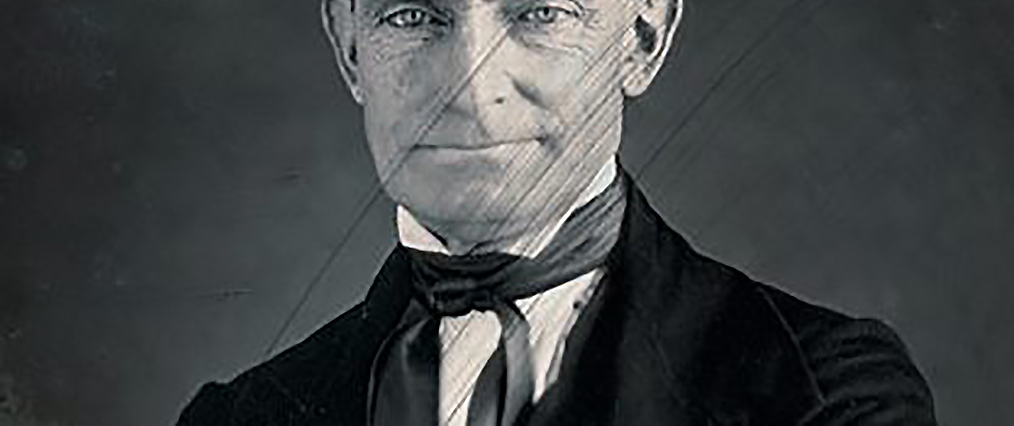John Brown’s father, Owen Brown, was a Calvinist who believed that slavery was a “breach of divine law” and that if we didn’t put a stop to it, God would have no choice but to “bring his wrath down on to America.”
John grew up in a house where his father practiced what he preached and often helped fugitive slaves make a new life for themselves in the North.
His father was hawkish when it came to his children, always on the lookout for sin, all kinds of sin, and constantly schooling them against being overly attached to the physical world.
He beat John often.
In fact, John’s earliest memories as a child were of sin and then being chastised for it.
Owen Brown and his children were early settlers in Ohio and while it seemed everyone else was constantly getting into disputes with the Native Americans that lived there, Owen Brown never did.
Owen Brown never tried to proselytize them. He traded with them. He treated them with respect, spoke of them with respect, and made sure that John did as well.
As a child in Ohio, John hung around Native American children as much as he could and because of his experiences during this time John Brown always carried with him a respect and sympathy for Native Americans.
He would later write that those first few years in Ohio were the happiest and freest years of his life.
As an adult, John Brown stood apart from other white northerners in other ways besides having a sympathy for Native Americans. He also stood apart because he referred to “Negroes by their surnames, with the prefixes of Mr. and Mrs.” whenever he interacted with them, which very few whites ever did.
In the 1850 U.S. census, the year the Fugitive Slave Act went into law, it lists a 23-year-old black laborer and fugitive slave from Florida living with John Brown and his family.
While other abolitionists, including black abolitionists, were using “moral arguments” to persuade southerners to recognize the inherent inhumanity of slavery, John Brown saw that route as pointless.
When John was twelve years old, he witnessed a slave boy who was roughly his same age being horribly beaten by two grown men with iron shovels for not working fast enough.
This act of violence towards a defenseless child left a profound impression on him.
He felt a connection with this young boy and what he imagined must’ve been the hopeless condition of slave children, children who had no one to stand up for them, or in this case, even stand between them and grown men who didn’t hesitate to beat a child with iron shovels.
John’s logic was simple. John figured that anyone who doesn’t already understand that beating a child with iron shovels or prying a crying infant from its mother’s arms to settle a gambling debt is wrong, isn’t going to be persuaded by reading them a scripture from the Bible or appealing to their conscience.
After the passing of the Missouri Compromise in 1850 it had become popular among pro-slavery conservatives to refer to slavery as the South’s “peculiar institution”.
John Brown hated that euphemism, “peculiar institution”.
John knew that calling slavery the South’s “peculiar institution” was a deliberate and purposeful use of language. The purpose was to give the impression to northerners that slavery was distinctive to the South, so as long as it remained in the South it was none of their business.
And for a while, it seemed to work. As long as slavery stayed in the South MOST northerners simply chose to tolerate slavery or ignore slavery altogether.
As far as John Brown was concerned, everyone was missing the point.
John Brown understood that the reason most northerners didn’t want to see slavery expanded had NOTHING at all to do with the moral question of slavery and EVERYTHING to do with not wanting to compete with enslaved Africans for work.
It was easy to understand. Slaves work for free. That is what a slave does. Slavery diminished both the status and prospects of the deluge of European immigrants coming to America that hoped to build a better life for themselves.
They didn’t come all the way to America to work for scraps. Hell, if they were going to be poor and hungry they could’ve stayed where they were.
John Brown was against slavery on the principle of it. This is what made him different.
And to his disappointment, even in the north, he found himself surrounded by very few white Americans who saw slavery the way he did.
The Fugitive Slave Act of 1850 penalized people who failed to arrest an alleged runaway slave, and made them liable to a fine of $1,000 (about $28,000 in present-day value).
That was the straw that broke the proverbial camel’s back for many Northerners.
John Brown believed that there was only one way to get rid of slavery in America.
As long as there were slave owners, there would always be very wealthy slave owners. As long as there were wealthy slave owners, they would continue to have influence in government. As long as they had influence in government they would continue to get laws put in place that would, if not strengthen slavery, at the very least protect it from going anywhere.
The solution was simple.
Get rid of slave owners.
While the rest of the south flew into a panic after Nat Turner murdered 60 slave owners and their wives and children in their beds while they slept, John Brown thought Nat was on to something.
Yes, it was true that after Nat Turner’s revolt it was illegal to teach a slave how to read and write. Yes, it was true that free blacks had lost the right to own guns to hunt for food or defend themselves. Yes, it was true that it was now illegal for blacks to congregate and talk without having a white person present to listen to everything they said. And that they were even forbidden to preach in their own churches to their own congregations. But it was equally true, John believed, that supporters of slavery wouldn’t be persuaded by argument.
Senator Jefferson Davis of Mississippi, before he would go on to become the President of the Confederacy, was advocating in the Senate that the United States should take over the island of Cuba as well as the Yucatan peninsula so that they could expand their plantations and slavery there as well. His fellow Mississippian Senator Albert Brown didn’t want to stop there. He wanted the United States to go take all of Central America too.
To John, this was evidence that their greed was insatiable; they were arrogant and too far-gone to be reeled in. He believed that he was being called on by God himself to do something about them.
Dozens of autobiographical accounts had been published detailing the horrors of slavery by former slaves and all the south did was counter with romantic pro-slavery literature called “plantation literature”, which was pure fiction depicting slaves as content, simple minded, harmless pets that loved their masters even more than their masters loved them.
John had personally met and broken bread with many fugitive slaves and had listened to their stories, had seen firsthand their “stripes” (scars permanently left on their bodies from floggings) and had even hosted dinner parties in his own home with prominent abolitionists of his time like Fredrick Douglass.
John Brown had already tossed this idea of armed insurrection with several black Abolitionists including Fredrick Douglass and Douglass had told him that what he had planned just wasn’t feasible.
Which is a nice way of saying, “are you nuts?”
But when John Brown met Harriet Tubman and told her the exact same plan, she didn’t think it was a bad idea at all.
In fact, even though Harriet now lived in Canada she immediately began recruiting foot soldiers for John Brown as well as advising him on how best to infiltrate the south from the north.
In no time Harriet had become so valuable to John Brown that he wrote in a letter to his son that, “He Harriet is the most of a man naturally; that I ever met with.”
Although Harriet didn’t know it, Canada wasn’t even safe for her.
Now we know that slave owners had hired men to go into Canada to look for her suspecting that she might be doing just what she was doing, staying low in Canada in between runs down south. Those men had been given orders that if they did find her not to bother bringing her back to the states but to just murder her in cold blood.
Like Denmark Vesey before him, Brown believed that numbers would be on his side.
John Brown believed that as soon as word got out to slaves that an armed rebellion to win their freedom had begun, that slaves (who outnumbered their white masters 20 or 30 to 1 in some areas) would pick up whatever they had; shovels, rakes, knives, stones and join the fight to ensure its success.
He saw the south as a powdered keg just waiting for a spark.
But in order to provide that spark he would need guns, and lots of them.
But where does one find enough guns to arm an Army?
Why the United States Armory and Arsenal at Harpers Ferry, of course.
Knock. Knock.

